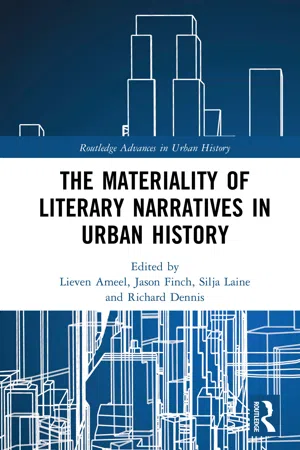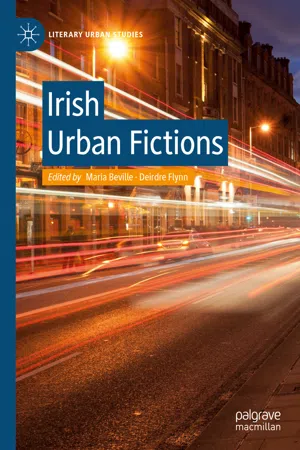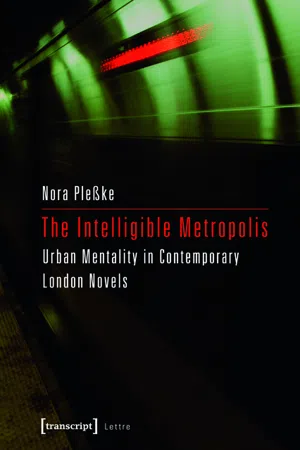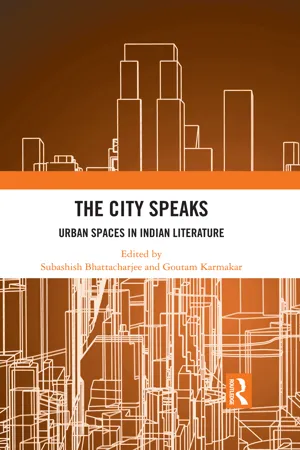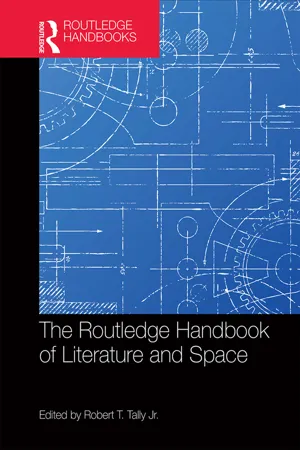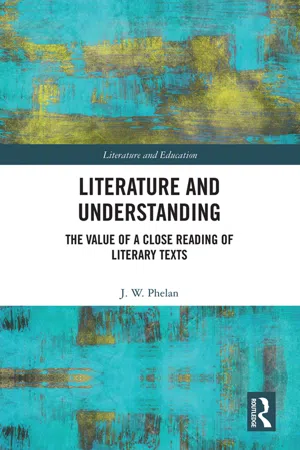Literature
Urban Fiction
Urban fiction is a literary genre that focuses on the lives and experiences of characters in urban settings, often depicting the struggles and realities of inner-city life. It typically explores themes such as crime, poverty, and street culture, and is known for its raw and gritty portrayal of urban environments. This genre has gained popularity for its authentic representation of urban life.
Written by Perlego with AI-assistance
Related key terms
1 of 5
7 Key excerpts on "Urban Fiction"
- Lieven Ameel, Jason Finch, Silja Laine, Richard Dennis(Authors)
- 2019(Publication Date)
- Routledge(Publisher)
The first section of the book, ‘Literary Fiction as Urban Materiality’, examines literary writing in genres such as the novel and the lyric poem as a complex and highly aestheticised investigation of urban material structures. It focusses in particular on how literary texts provide insights into embodied experiences of historical cities. At the same time, literary fiction is introduced here as being part and parcel of urban materiality: literary texts and literary production are constitutive of specific kinds of urban experience and their renderings in narrative form. Among other things, literary texts are also part of the city. They are manufactured productions of the city as surely as are railings, clocks, and buses.In addition to being of the city, literary narratives investigate and comment upon the environment in which they were formed. The book’s second section, ‘Literary Narratives as Social Investigations of the Material City’, approaches literary narratives as providers of tactile knowledge concerning the history of urban poverty and urban social problems, and concerning marginalised groups in the city. Narrative forms and genres such as poetry, children’s comics, and literary journalism will be foregrounded in this section as useful sources for urban history – text types that in literary urban studies, with its focus on the prose novel, have remained somewhat underdeveloped. Narratives are seen here as investigating, discursively constructing, and actively shaping responses to urban social problems.The book’s third section is entitled ‘Narrating Silenced Material Lives’. This section examines literary narratives as important sources for documenting the qualitative aspects of material lives that without them would have disappeared and as tools for reconstituting earlier silenced spatial and material histories. New insights into forgotten, neglected, or otherwise inaccessible voices in urban history are in this section brought centre stage through the examination of literary narratives.Literary Fiction as Urban Materiality
In the first chapter in this section, ‘Between the Street and the Drawing Room: Slumming in Eliot’s Early Poetry’, Bo Pettersson examines T.S. Eliot’s early poetry in view of Eliot’s predilection for slumming. Pettersson argues that Eliot’s detailed observations of upper-class life must be set against his equally searching scrutiny of prostitution, squalor, and decay in rather explicit language. The article shows that nightly strolls and related reading, especially Charles-Louis Philippe’s slum depictions Bubu de Montparnasse and Marie Donadieu , helped to open the young Eliot’s eyes to another side of urban life that informed much of his early poetry and set him on the path to The Waste Land- eBook - ePub
- Maria Beville, Deirdre Flynn, Maria Beville, Deirdre Flynn(Authors)
- 2018(Publication Date)
- Palgrave Macmillan(Publisher)
Writers and characters in these fictions engage with Irish places, fictional and real, and the cultural implications of the specifics of representation are important. The chapters in this volume examine how Irish urbanites see themselves within their own urban spaces and how narratives of identity are conjoined with narratives of place. In doing so they ask how does the rural Irish literary tradition impact on their experience of the city? How do urban Irish locations differ from recurring images of the city in literature? And does the unique cultural and historical past and present of the island of Ireland create contrasting urban experiences north and south of the border? These are questions specific to Irish Urban Fictions. They challenge us to think about important issues relevant to the literary urban landscape. McNamara suggests that literary forms have been the ‘building blocks of […] collective identity for millennia’. 29 If so, then what does the collective cultural identity of the urban suggest about Ireland? And how has urban literature contributed to the development of this collective identity? A Multilateral Perspective The chapters in this book approach the city and the urban spaces that unfold within and around it, by drawing the concept of ‘Irish fiction’ away from notions of the rural and the regional. The collection’s vision expands the idea of the city in Irish writing to reveal a host of utopian, dystopian, and heterotopic textual spaces that frequently converge with the consciousness of the city dweller. In doing so, it forms a perspective which opens up the urban in Irish fiction as an important site for social commentary on contemporary Irish culture and society. Each of the three sections builds on these notions, and the chapters therein combine to form a critical introduction to Irish Urban Fictions - eBook - PDF
Books and Beyond
The Greenwood Encyclopedia of New American Reading [4 volumes]
- Kenneth Womack(Author)
- 2008(Publication Date)
- Greenwood(Publisher)
This dynamic also appears in the lives of the genre’s authors, including Goines and Stringer, who grew up in middle-class homes on the East Side of Detroit, but gravitated to street culture and drug sales (Cunningham). Here, too, the new popular genres often come down on the side of the culture argument. Conventional upward mobility is often available in these novels; it is not economic pressure but the allure of a morally defiant, physically adventurous version of ghetto life that often triumphs, if not over the main character then over the majority of her peers. Reception. The reception of Urban Fiction speaks to the difficulty in defining it, a difficulty grounded in the divide in marketing and perception between literary and genre fiction. Works offered as literary—often in the genres of neighborhood, detec- tive, and historical novels—are less often assessed in terms of how they imagine the city than in terms of how they imagine the mental and moral lives of their charac- ters. A prominent reviewer praises Mosley’s Always Outnumbered, Always Outgunned, because he “has not appliqued his morality; he has located its deep coiled root and tracked it up to the surface” (Birkerts). In a review of Pete Hamill’s North River, New York City is a source of “detail and ambience” that “showcases” the novel’s deeper truth, which is “the power of human goodness and . . . love” (Publishers Weekly). While these novels are undoubtedly psychological, inattention to the ways they are informed by their conceptions of cities is another way in which, in popular cul- ture, the “urban” field is ceded to genres that can be most directly associated with black youth culture. - eBook - PDF
The Intelligible Metropolis
Urban Mentality in Contemporary London Novels
- Nora Pleßke(Author)
- 2014(Publication Date)
- transcript Verlag(Publisher)
This active participation of the ur-ban in structuring the narrative casts a “shift from ‘narrated cities’ to ‘urban narratives’” (Tygstrup cit. in Tinkler-Villani 2005a: xii). Accordingly, paradigmatic city novels that are narratologically connected to the metropolis must be considered, in Wolfgang Hal-let’s (2009: 84) terms, “ fictions of space ” in the sense that they also devise new forms of spatial constitution or problematise the arbitrariness of spatial constructions. The se-mantisation as well as the depiction of consciousness is predominantly formed by spatial relations. Hallet ( ibid. : 108) defines fictions of space as narratives in which: (a) space is the focus of the story, (b) processes of consciousness are imitated by spatial semiotics, (c) intradiegetic and extradiegetic commentaries are explicitly directed towards the issue of space, (d) the fictionalisation of space is connected to individual and cultural construc-tions of space and reveals this constructive moment. (5) While these definitions can be a helpful orientation within literary analysis, the London novel is not entirely limited to the ‘genre’ of the city novel as defined above (cf. Klotz 1987: 10; Hertel 1997: 19). Strictly following such categories of differentiating ‘London writing’ from a ‘writing about London’ would lead to a neglect of Urban Fictions which are considered London novels by ‘convention’ (cf. Coverley 2005; Pleßke 2006: 56-60). This includes, for example, nineteenth-century city novels of social critique (i.e. Introduction | 23 Arthur Morrison’s The Child of the Jago ) which had their revival in the political engage-ment with the effects of Thatcherism or in contemporary neo-realist ecological novels by first-and second-generation immigrants (cf. Coverley 2005: 14-15; Cuevas 2008b: 385). - eBook - ePub
The City Speaks
Urban Spaces in Indian Literature
- Subashish Bhattacharjee, Goutam Karmakar, Subashish Bhattacharjee, Goutam Karmakar(Authors)
- 2022(Publication Date)
- Taylor & Francis(Publisher)
Recent humanities scholarship has shown an inclination towards studying the city culturally, socially, and politically, projecting and presenting ever-new paradigms of study and scholarly recreation by engaging the spaces of, within, and without the cities. The cities in books by David Harvey, Douglas Murphy, Ravi Sundaram, Vinay Lal, Ash Amin, and Nigel Thrift, among others, show cities as actants in a world that has to evolve through technology and constant and increasingly complicated human interaction. In recent years, there has been a rise in the cultural interactions between the city and literature, marking zones of national, cultural, and linguistic interest specific to geographical conditioning and a greater cohesion of the idea of the cities through narratives, and this has led to the production of at least a few books that try to decode the literary in the urban and the urban in literature, to put it rather simplistically.The city has been a zone of contention for a considerable amount of time in literature – a producer of narratives as well as a consumer. These cities have embodied their characters and their narratives in a way that is reflective of the city’s topology, genealogy, and living archaeology. Literature, therefore, often serves to excavate the cities through its representations, and is also, in turn, unearthed. Rather than seeing the city as a null-space that exists horizontally to frame the literary work, cities in literary works from its diverse cultural and national histories have become more serpentine, transgressive, and unpredictable. These cities can be utopias or dystopias, safe havens or places of terminal oppression, but they are functional mechanisms that are more often than not an intricate aspect of the text/performance itself. Within this vast historio-’city’, the urban space in Indian literature has reached a tipping point, a point of intervention that necessitates that these adaptations be evaluated subjectively, informed by the nuances of critical theorisation, rather than as a mere set of pieces. But not merely in the area/s of literary creation, the burgeoning sphere of media studies surrounding urban spaces/spatialities in India has led to the mushrooming of such developments as the Sarai programme (CSDS and the Raqs Media Collective), and its consequent research output that is accessible through their site, and Vinay Lal’s two-volume The Oxford Anthology of the Modern Indian City besides a whole host of other works that discern the Indian city (or analogical ‘others’ to Indian cities) as the host-space, the ground zero for a fomentation of change, a site of evolution, and dissemination of radical thought. And this radical thought pervades the literary works that feed on cities. While such a commentary poses the risk of being elitist and exclusive in nature – by keeping the rural space outside its deliberation – historically, India has a stronger literary tradition of rural spaces than a similar correspondence with urban spaces. Independence, followed by the Emergency, and thereafter the liberalisation of the economy, finally pushed the attention of writers towards the urban centres as more than mere props. Therefore, even if we are to casually remark on the status of Narayan’s Malgudi as contentious towards an urban-representative literary state, it is indeed a more deliberate attempt to ingratiate the city within the story until it is no longer so – Narayan fleshes out Malgudi progressively while it corresponds to a native tradition of rural-urban narrative, and acts more in line with a rural-revivalist narrative. But the more recent developments have been more decisive in this regard. An Anita Desai novel that chronicles the city – In Custody - eBook - ePub
- Robert Tally Jr., Robert T. Tally Jr.(Authors)
- 2017(Publication Date)
- Routledge(Publisher)
Part IV Cities and the geography of urban experience 21 The City Novel Measuring referential, spatial, linguistic, and temporal distances Lieven Ameel Introduction The world has moved into the urban century, an era in which the majority of the human population resides in cities. The centuries during which the urban condition, in all its myriad forms and varieties, has gradually become the most common mode of existence have also seen the consolidation and expansion of a vast literature of the city, evoking, scrutinizing and shaping city life in its many ramifications. The advance of the city novel as a genre has correlated with fluctuations in the urban condition, as well as in urban tastes. Similarly, the demise of the city as a dominant literary topos has been read as the equivalent, in literature, of the failure of the city to provide a focal point for radical aspirations. 1 While a vast amount of research has been conducted on the images and experiences of the city in the literary works of individual authors, and on the literatures of particular cities and literary periods, less progress has been made to articulate what distinguishes city novels from other literary texts - eBook - ePub
Literature and Understanding
The Value of a Close Reading of Literary Texts
- Jon Phelan(Author)
- 2020(Publication Date)
- Taylor & Francis(Publisher)
Fiction is a species of language use (applied to names, sentences and discourses) and is neutral as to value. Literature, even in the narrowest sense applied to imaginative and creative writing, is a kind of discourse, essentially valued, which affords and invites a distinctive kind of appreciation.(Lamarque 2014: 69)Actually, ‘fiction’ is subject to evaluation on some occasions. Karl May was condemned when his novels set in the Wild West, and reputedly based on fact, were revealed as fiction. In this instance, the disappointment of many readers extended beyond disappointment at being hoodwinked to dissatisfaction at being left with ‘mere fiction’. In another type of case, fiction may be criticised for containing factual inaccuracy. A novel set in Cambridge which contains the line ‘I left Magdalene College and walked across the road to the Fitzwilliam Museum’ contains a factual accuracy and one that would disturb a reader familiar with the city. Let us also imagine that this detail served no purpose in the novel so could not be excused as ‘poetic license’. This type of case results in a kind of imaginative resistance, of a non-moral kind, which leads to a negative evaluation of the work. Here genre convention plays a role in evaluation. If the novel is realist fiction and if a particular detail is wrong about the subject depicted, then the novel may be criticised for containing an error. In this second example, the work is criticised for being ‘too fictional’ given the genre conventions of realist fiction.Nevertheless, it is true that describing a work as a work of ‘fiction’ is not usually evaluative but the kind of categorisation publishers use to help readers distinguish what is invented from what is fact; for instance, to differentiate ‘true crime’ from ‘detective fiction’. In contrast, calling a work ‘literature’ is predominantly evaluative and involves some form of aesthetic appreciation. This kind of literary appreciation seems separate from personal preference; I may recognise a late Henry James novel as literature without the work being to my taste. The upshot of this brief discussion is that I am loath to dismiss the evaluative aspect of literature as it corresponds with our ordinary usage of the term and captures something of the Gestalt of reading a text as a work of literature.
Index pages curate the most relevant extracts from our library of academic textbooks. They’ve been created using an in-house natural language model (NLM), each adding context and meaning to key research topics.
